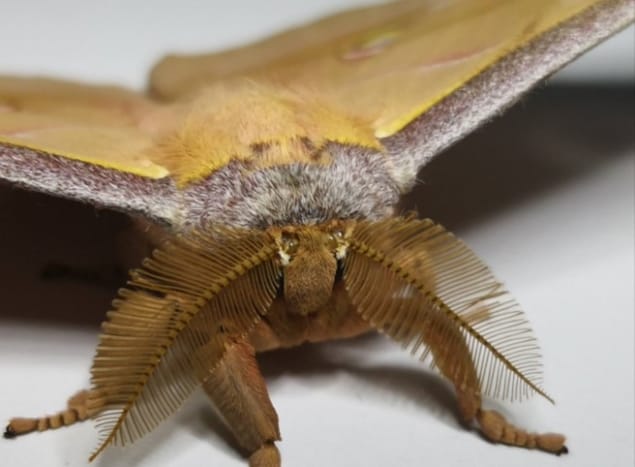Wallpaper made of moth wings is an excellent absorber of sound
07 Jul 2022
Stealthy flier: the Antheraea pernyi moth is very good at absorbing ultrasound. (Courtesy: University of Bristol)
When moth wings are used to coat hard, artificial surfaces, they can significantly reduce the reflection of incoming ultrasound, researchers in the UK have shown. Without making any modifications to the wings’ scale structures, Marc Holderied and colleagues at the University of Bristol showed how the natural metamaterial performs remarkably well as natural soundproofing.
Conventional soundproofing materials tend to be porous, and to be effective they must be thicker than about 10% of the wavelength of the sound they are blocking. Metamaterials made of specially designed structures can be thinner than 1% of the wavelength they absorb, but these tend to operate over a very narrow band of frequencies. While broadband metamaterials have been created, they tend to be much thicker.
To create thinner broadband sound absorbers, some researchers are looking to the wings of moths for inspiration. Bats hunt moths using echolocation, so some moth species have developed a remarkable ability to absorb the high-frequency sound waves bats produce. The insects do this using microscopic scales that decorate both sides of their wings.
Range of sizes
These scales come in a broad range of sizes – each with a characteristic resonant frequency. This allows the wings to absorb sound across a wide range of frequencies, making them far more effective than conventional sound-absorbing materials. Previous studies have shown how moth wings absorb sound waves as the insects travel through the air. In their study, Holderied’s team looked at how the wings absorb sound when attached to an aluminium disk.
Typically, such a hard, manmade surface will reflect most incoming sound. In contrast, the researchers observed that the moth-wing coating reduced this reflection by up to 87% at the lowest frequencies they tested. The ultrasound used by the team had wavelengths some 50 times longer than the thickness of the wings.READ MORE

The team then had a closer look at how the sound was absorbed. They removed the scales from the upper side of the wing and discovered that this caused the absorption to vary with the orientation of the incoming sound. While its performance remained high when the bald side faced the incoming sound, it broke down almost completely in the orientation. By recreating this scenario in simulations, Holderied’s team showed that the metamaterial’s performance strongly depends on the presence of scales in the air gap between the wing membrane and the hard surface beneath.
The sound waves absorbed by moth wings may be beyond the range of human hearing, but by adapting the design to absorb lower frequencies, Holderied and colleagues hope that new artificial metamaterials inspired by their structure could soon be developed. These structures could lead to new breakthroughs in high-performance soundproofing: potentially leading to coatings for walls, vehicles, and noisy machinery that takes up a fraction of the space required by existing materials.
The research is described in Proceedings of the Royal Society A
Sam Jarman is a science writer based in the UK.
From physicsworld.com 7/9/2022

Δεν υπάρχουν σχόλια:
Δημοσίευση σχολίου